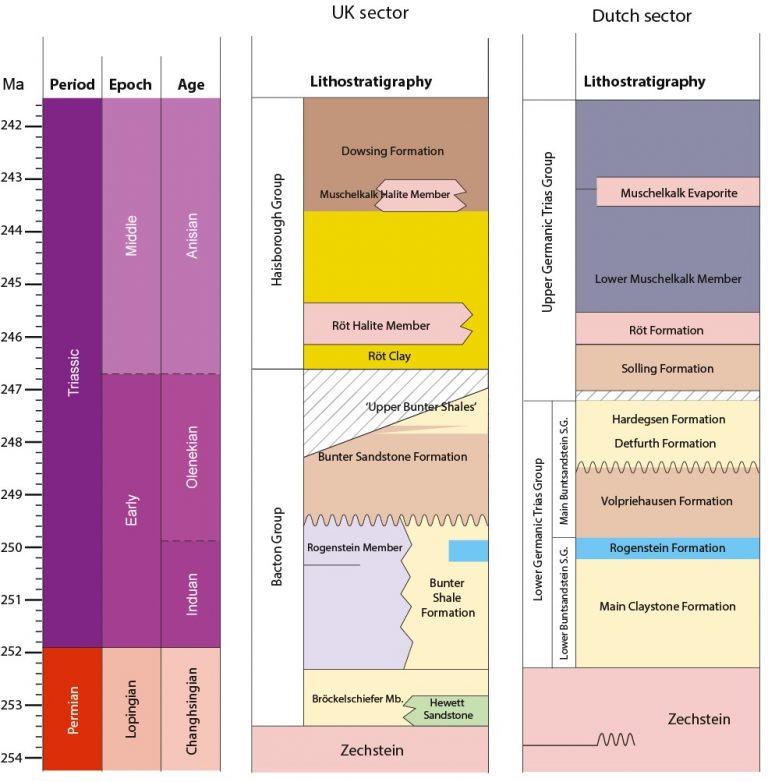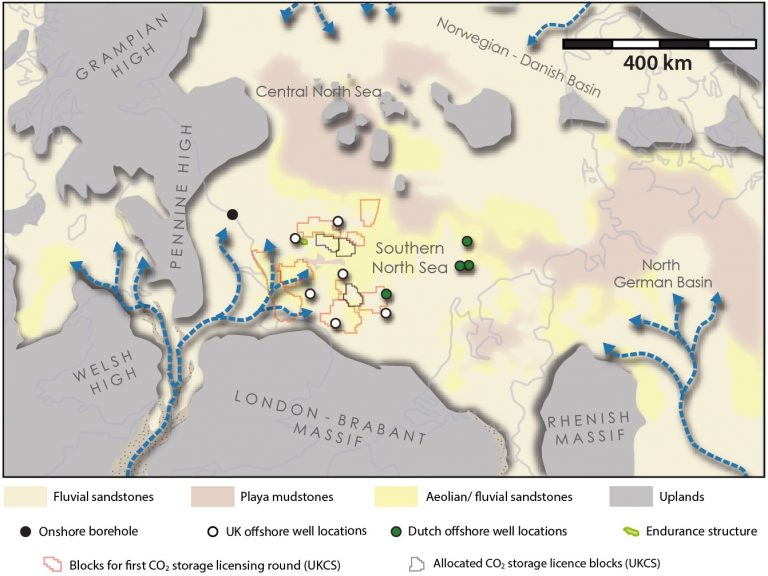Reservoir composition and diagenesis (CASP.BSSC.4)
The Bunter Sandstone Formation and correlative strata in the Dutch sector of the Southern North Sea (Fig. 1) are important candidate reservoirs for the geological storage of CO2 and will play a key role in the UK’s Net Zero Strategy. The formation and its equivalents comprise laterally variable continental red bed sequences deposited under arid to semi-arid conditions in a low-energy, ephemeral fluvial to aeolian-sabkha environment. However, there is notably little published information on its stratigraphy.
This study will investigate sedimentologic, petrographic and diagenetic controls on reservoir quality to inform the assessment of CO2 injectivity and plume migration studies to ensure safe, long-term CO2 storage in the subsurface.
This project forms part of CASP’s Bunter Sandstone Storage Complex research theme and will be supported by complementary research projects aiming to build a biostratigraphic framework and a regional correlation of Early to Middle Triassic strata across the UK, Dutch and Germanic sectors of the Southern North Sea. It will also provide a framework for concurrent sediment provenance research.

Research programme
This project will combine sedimentological analysis with SEM-derived automated mineralogy, petrography and porosity-permeability measurements in order to constrain how reservoir quality is controlled by changes in sedimentary environment of deposition, sandstone composition and diagenetic evolution, as well as to document its lateral and vertical heterogeneity. Particular focus will be placed on diagenetic sequences and cements. Newly available borehole core from the Woodsmith Mine, North Yorkshire will provide material for a high-resolution study, along with core from selected wells of the UK and Dutch offshore (Fig. 2), including the Endurance appraisal well. Sampling will focus principally on the Bunter Sandstone Formation and the correlative units of the Dutch sector (Fig. 1). The collected compositional data will be used to populate reactive transport models in a later phase of our research.

Deliverables
Results will be delivered via an interim data release with an associated presentation for client companies and a final technical report containing:
- Detailed sedimentary logs for the studied cores (covering approximately 1000 m)
- Facies analysis (in the form of tables and charts)
- Compositional data and charts
- Porosity-permeability data
- SEM Mineral maps and petrographic descriptions
- Diagenetic sequences
It will conclude with a client workshop during which all data and interpretations will be presented and discussed.
Project duration
The project will launch at the beginning of July 2022 and has a planned duration of 18 months.
Contact: Michelle Shiers for further information about this research and licensing options.
Products
- Thematic Research
- Mudrock Seals in CO2 Storage Systems Thematic Research
- Bunter Sandstone Storage Complex Thematic Research
- A palynozonation of the Bunter Sandstone CO2 storage complex: onshore analogue study (CASP.BSSC.1)
- Palynostratigraphy of the Bunter Sandstone CO2 storage complex in the Southern North Sea (CASP.BSSC.2)
- Cyclostratigraphy of the Early to Middle Triassic of the Southern North Sea (CASP.BSSC.3)
- Reservoir composition and diagenesis (CASP.BSSC.4)
- Controls on Bunter Sandstone composition (CASP.BSSC.5)
- Middle Triassic seals – onshore analogue study (CASP.BSSC.6)
- Middle Triassic seals – UK and Dutch offshore wells study (CASP.BSSC.7)
- Reactions and Flow of CO2 Fluid in Compositionally Immature Sandstones Thematic Research
- The Impact of Volcaniclastic Rocks on CO2 Storage Thematic Research
- Non-thematic Research
- Reports
- Data Packages
- Geological Collections and Data
